| 1. | Introduction |
| 2. | A bit of theory |
| 3. | Sky |
| 4. | Rainbow |
| 5. | Reflexion |
| 6. | Absolute no! |
| 7. | Conclusion |
This filter is offered under various names. It can be a Landscape Filter or Landscape CPL because it finds its main use in landscape photography. CPL means circular polarizing lens although it is not a lens but a filter. We will address circular polarization later.
Polarizing filters are connected with a few myths. In order to understand the truth we have to start with a bit of theory.
Light polarization as a phenomenon belongs to physical optics. Detailed describtion including mathematical equations can be found in many documents even on the internet including Wikipedia. However, such exact describtion is not needed for our purpose, a simplified explanation of basic priciples will be sufficient. The pictures, used in this section, are displayed directly from Wikimedia Commons.
Wave character of light can be viewed as a sinus curve along the axis of light transmission. However, the light does not oscillate in one plane but randomly in all planes. Such light is called unpolarized. It is possible to allow light oscillating in one plane only to pass through. Such light is called linearly polarized. Linear polarization is shown on a picture below. If we inserted another linear polarized to the path of linearly polarized light, the result would depend on their mutual angle. In zero angle the light would pass through, in angle of 90° the light would be blocked.
Light polarization occurs also in the nature. The best known source of linearly polarized light is blue sky in a sunny day, especially in the direction perpendicular to the direction of sun beams. Since the light reflected from other objects is unpolarized, the polarization filter allows us to darken the sky without a colour shift.
Polarized light presents a substantial disadvantage, the semiconductor electronic devices react to the polarized light, we can thus consider them another polarizer in the path of the light. It can thus happen that no light will approach the chip for exposure measurement and focusing. The problem appeared even on very old film cameras with TTL (through the lens) exposure measurement. The opposite side of a linear polarizer is therefore equipped with a quarter-wave plate which changes linearly polarized light to the circularly polarized one which behaves to the optoelectronics the same way as the unpolarized light. The scheme is shown below.
The animated picture below shows the circularly polarized light. Two polarizations are possible, they differ by the direction of rotation, clockwise or counter-clockwise.
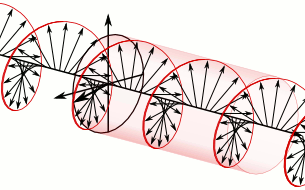
Different kinds of polarization are illustrated on the following page in Hindi Wikipedia where (from left to right) समतल ध्रुवित denotes linearly polarized, दीर्घवृत्त ध्रुवित elliptically polarized, and वृत्त ध्रुवित circularly polarized light: ध्रुवण के प्रकार. The page will be opened in a separate window.
The most important is:
A polarizing filter is most frequently used in landscape photography where sky is a part of the picture. The sky light is partially linearly polarized, the highest fraction of polarized light being perpendicular to the direction of the sun beams. The light reflected by clouds is unpolarized. The polarizing filter thus increases the contrast between clouds and the sky. Since the fraction of the polarized light varies with the angle, the colour of the sky changes on the wide-view pictures. Notice that on the pictures below, the colour of the sky changes both horizontally and vertically.
 |
 |
Rainbow is formed by refraction on water drops, its light is therefore linearly polarized. The angle of rotation of a polarizing filter is thus important. In one angle the rainbow is supressed, after rotation 90° it is enhanced and part of the sky light is filtered out which is responsible for colour change (no colour correction was done in software postproduction). The pictures were not taken from a tripod.
Light reflected by some materials is linearly polarized as well. Water surface belongs to the class of such materials. The example below shows how mirroring of sky on a water surface was enhanced by a polarizing filter.

Reflection in glass is also polarized. A sample on page Vermeidung von Spiegelungen shows (from left to right) a picture without a filter, enhancement of reflection and suppression of reflection.
The next picture presents comparison of reflection in a window with and without a polarizing filter. You can see that the sky and even the roof are slightly polarized on the view outside. If you move the transition to the left you can see that the colour of the building in the reflection changes. It is caused by he fact that the wall behind the window is painted with a light yellow colour. If the filter is not used, the reflection is mixed with the light yellow light reflected by the wall. If the polarizing filter is oriented in a direction enhancing reflection, the majority of the yellow light is suppressed and the colour of the mirror image of the building will be close to the colour of the building outside.
Light reflected by the crystals of minerals is also linearly polarized. The colours as shown on the picture below are not visible by a naked eye but were enhanced by use of a polarizing filter.

Many hints for photographers contain false myths saying in which situation a polarizing filter must not be used. One instruction is, however, correct. We have said the in case of pictures of sky, the fraction of polarized light depends on the angle. A polarizing filter thas cannot be used on wide-angle lenses as shown on the next picture. The photo acquired with the filter contains an unnatural dark strip while the coour of sky on the photo without the filter is well balanced.
LCD displays are yet another source of linearly polarized light. The picture below presents a desktop monitor, iPad, iPhone, and a digital clock. Notice that the polarization algle varies on different displays.
| Effect of an angle of rotation of a polarizing filter (top left without a filter) | |
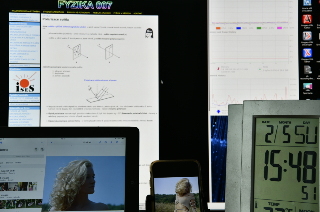 |
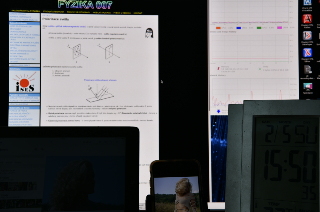 |
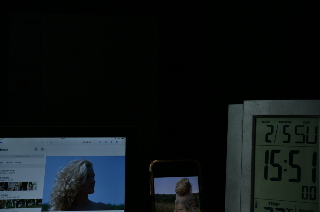 |
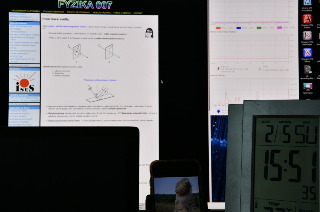 |
The iPhone is the only device which was not absolutely black on any angle. Its display is probably equipped with a quarter-wave plate. Its effect depends on the wavelength. The upper strip on the picture on the left (without a filter) is white unless you have activated a night mode of your monitor. The next two pictures show that the polarization is elliptical and considerable colour shift can be observed. I made only visually a similar experiment with displays in the Toyota Auris car. The light of the multi-information display (below the steering wheel) is polarized linearly while the multimedial display (containing the GPS navigation) is equipped with a high quality quarter-wave plate ensuring circular polarization in the whole visible spectrum.
| Effect of an angle of rotation of a polarizing filter (iPhone XS Max) | ||
|---|---|---|
 |
 |
 |
| No filter | ~ 0° | ~ 90° |
We have not done any real test in this part. After brief explanation of theory we have demonstrated usage, disproved myths and explained in which situations the polarizing filter should not be used. Now you can certainly prove whther your own filter is a real polarizer.